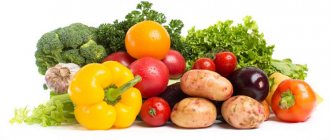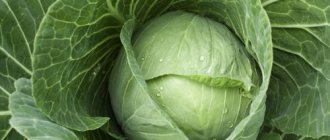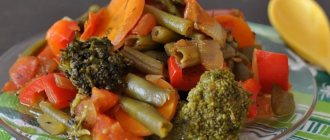Lecho is a classic Hungarian dish that does not have an exact recipe. The composition necessarily includes bell peppers, ripe tomatoes and onions. Any available vegetables and spices are used as additional ingredients: carrots, ground pepper, bay leaf, cloves, chili peppers, fried onions.
Did you know? Classic Hungarian lecho is eaten as a separate dish with plenty of white bread. Before serving, combine it with stirred eggs.
Hungarians also love to cook lecho with homemade sausages and smoked meat.
Compound
Lecho is an excellent source of vitamins and other useful substances. That is why the product is so popular in European countries and in Russia.
Lecho retains most of the vitamin C, A, PP, B1, B5, B6. The mineral composition of the product is no less diverse, represented by selenium, phosphorus, magnesium, calcium, zinc, manganese and iron.
Interesting fact! The chemical composition of lecho can vary, it all depends on the ingredients used for its preparation.
Properties of Lecho
Nutritional information | Vitamins | Minerals
How much does Lecho cost (average price for 1 ban)?
Moscow and Moscow region.
60 rub.
Lecho received its original name thanks to the classic dish of Hungarian national cuisine called lecso. It is noteworthy that lecho is popular not only in its historical homeland in Hungary. European and domestic housewives adopted the lecho recipe a long time ago. In the fall, gardeners and vegetable gardeners harvest a rich harvest of vegetables, which they want to prepare for the winter in order to “recharge” with vitamins and beneficial natural compounds from them during the cold season. Lecho is a great way to prepare fresh vegetables for future use.
Benefit
With regular consumption of the valuable bell pepper product, the body is enriched with vitamins and minerals. The product is especially beneficial in winter, when there is a shortage of fresh vegetables everywhere.
Using lecho, you can:
- strengthen blood vessels;
- avoid depression;
- improve skin condition;
- improve memory and vision.
- normalize blood pressure;
- strengthen the immune system.
Interesting fact! Basically, lecho has a low calorie content, which gives grounds to classify it as a dietary product.
Calorie content Pepper lecho in tomato sauce. Chemical composition and nutritional value.
Nutritional value and chemical composition of “Pepper lecho in tomato sauce.”
The table shows the nutritional content (calories, proteins, fats, carbohydrates, vitamins and minerals) per 100 grams of edible portion.
| Nutrient | Quantity | Norm** | % of the norm in 100 g | % of the norm in 100 kcal | 100% normal |
| Calorie content | 50 kcal | 1684 kcal | 3% | 6% | 3368 g |
| Squirrels | 0.8 g | 76 g | 1.1% | 2.2% | 9500 g |
| Fats | 0.3 g | 56 g | 0.5% | 1% | 18667 |
| Carbohydrates | 13 g | 219 g | 5.9% | 11.8% | 1685 g |
| Alimentary fiber | 1.2 g | 20 g | 6% | 12% | 1667 g |
| Water | 91.25 g | 2273 g | 4% | 8% | 2491 g |
| Ash | 3.75 g | ~ | |||
| Vitamins | |||||
| Vitamin A, RE | 26 mcg | 900 mcg | 2.9% | 5.8% | 3462 g |
| Vitamin B1, thiamine | 0.025 mg | 1.5 mg | 1.7% | 3.4% | 6000 g |
| Vitamin B2, riboflavin | 0.03 mg | 1.8 mg | 1.7% | 3.4% | 6000 g |
| Vitamin B5, pantothenic | 0.038 mg | 5 mg | 0.8% | 1.6% | 13158 g |
| Vitamin B6, pyridoxine | 0.178 mg | 2 mg | 8.9% | 17.8% | 1124 g |
| Vitamin B9, folates | 16 mcg | 400 mcg | 4% | 8% | 2500 g |
| Vitamin C, ascorbic acid | 46.5 mg | 90 mg | 51.7% | 103.4% | 194 g |
| Vitamin RR, NE | 0.55 mg | 20 mg | 2.8% | 5.6% | 3636 g |
| Macronutrients | |||||
| Potassium, K | 146 mg | 2500 mg | 5.8% | 11.6% | 1712 g |
| Calcium, Ca | 41 mg | 1000 mg | 4.1% | 8.2% | 2439 g |
| Magnesium, Mg | 11 mg | 400 mg | 2.8% | 5.6% | 3636 g |
| Sodium, Na | 1369 mg | 1300 mg | 105.3% | 210.6% | 95 g |
| Sera, S | 8 mg | 1000 mg | 0.8% | 1.6% | 12500 g |
| Phosphorus, P | 20 mg | 800 mg | 2.5% | 5% | 4000 g |
| Microelements | |||||
| Iron, Fe | 0.8 mg | 18 mg | 4.4% | 8.8% | 2250 g |
| Manganese, Mn | 0.16 mg | 2 mg | 8% | 16% | 1250 g |
| Copper, Cu | 130 mcg | 1000 mcg | 13% | 26% | 769 g |
| Selenium, Se | 0.3 mcg | 55 mcg | 0.5% | 1% | 18333 g |
| Zinc, Zn | 0.18 mg | 12 mg | 1.5% | 3% | 6667 g |
| Essential amino acids | |||||
| Arginine* | 0.038 g | ~ | |||
| Valin | 0.034 g | ~ | |||
| Histidine* | 0.016 g | ~ | |||
| Isoleucine | 0.026 g | ~ | |||
| Leucine | 0.042 g | ~ | |||
| Lysine | 0.036 g | ~ | |||
| Methionine | 0.01 g | ~ | |||
| Threonine | 0.029 g | ~ | |||
| Tryptophan | 0.01 g | ~ | |||
| Phenylalanine | 0.025 g | ~ | |||
| Nonessential amino acids | |||||
| Alanin | 0.033 g | ~ | |||
| Aspartic acid | 0.114 g | ~ | |||
| Glycine | 0.03 g | ~ | |||
| Glutamic acid | 0.106 g | ~ | |||
| Proline | 0.035 g | ~ | |||
| Serin | 0.032 g | ~ | |||
| Tyrosine | 0.017 g | ~ | |||
| Cysteine | 0.015 g | ~ | |||
| Saturated fatty acids | |||||
| Saturated fatty acids | 0.045 g | max 18.7 g | |||
| 14:0 Miristinovaya | 0.001 g | ~ | |||
| 16:0 Palmitinaya | 0.033 g | ~ | |||
| 18:0 Stearic | 0.011 g | ~ | |||
| Monounsaturated fatty acids | 0.02 g | min 16.8 g | 0.1% | 0.2% | |
| 16:1 Palmitoleic | 0.002 g | ~ | |||
| 18:1 Oleic (omega-9) | 0.018 g | ~ | |||
| Polyunsaturated fatty acids | 0.161 g | from 11.2 to 20.6 g | 1.4% | 2.8% | |
| 18:2 Linolevaya | 0.146 g | ~ | |||
| 18:3 Linolenic | 0.015 g | ~ | |||
| Omega-3 fatty acids | 0.015 g | from 0.9 to 3.7 g | 1.7% | 3.4% | |
| Omega-6 fatty acids | 0.146 g | from 4.7 to 16.8 g | 3.1% | 6.2% |
The energy value of lecho pepper in tomato sauce is 50 kcal.
Primary Source: Created in the application by the user. Read more.
** This table shows the average levels of vitamins and minerals for an adult. If you want to know the norms taking into account your gender, age and other factors, then use the “My Healthy Diet” application.
Use in cooking
You can prepare many delicious dishes based on lecho: stewed beef or pork with lecho, stew, chops with lecho. The finished product can be added to soups, borscht, cabbage soup, pickles, pies, and pizza.
Lecho is often served as a side dish for the main dish, complemented by vegetable side dishes, meat and fish dishes.
The product also goes well with smoked products, especially sausages and meat.
Interesting fact! Lecho is a variation of the famous dish ratatouille, adjusted to the products available in Hungary.
Classic lecho recipe
Any popular dish, as a rule, has many cooking options. And this is understandable, since every housewife strives to improve the recipe to her taste, giving it individuality and originality.
Traditionally, lecho included only three types of vegetables: tomatoes, sweet peppers and onions, but it could include various additives and seasonings. Therefore, in order to determine how many calories are in tomato and pepper lecho, it is important to know whether sugar and oil were added to it or not. If lecho does not contain these components, then its calorie content will be minimal - about 27 calories per 100 grams of product. Even those who are on a strict diet can afford such a snack, since it does not pose any danger to their figure.
However, it is worth considering that such a cooking recipe is not common, and lecho usually contains a certain amount of butter and sugar. How many calories are in pepper lecho in this case? If you are buying a finished product, the easiest way to find this information is on the label. If this is a homemade dish, then, on average, lecho prepared with the addition of butter will contain 72 calories, and if sugar is added, then 88 calories. As you can see, the calorie content of lecho is still not very high, however, you should not eat kilograms of it.
How to choose
To purchase a quality product, you need to pay attention to the following signs:
- the larger the ingredients, the tastier the lecho will be;
- uniform cutting;
- the marinade is homogeneous, without lumps;
- a pronounced color indicates the presence of dyes;
- can tightness;
- composition, which should contain only vegetables, vinegar and salt.
Valuable advice! The tightness of the lid is checked when opening the jar; a pop should be heard.
If the jar is not sealed, you should not take the risk and consume the product.
Winter preparations: harm, benefits and recipes for everyone
Autumn is the time of harvest and preparations, but not everyone can treat themselves to tomatoes from a jar, sweet jam and other gifts of nature preserved for the winter. We'll figure out who and why canned fruits and vegetables may be contraindicated, and share special recipes that combine the benefits with expert recommendations.
Who is contraindicated for canned food?
To be honest, canning is not the best way to preserve the benefits of fresh vegetables and fruits. After cooking and adding additional sugar and salt, unfortunately, there is not much benefit left in the products.
For example, a liter of marinade contains about 25 g of salt (1 tablespoon). Considering that the World Health Organization recommended limit is only 5 g per day, and you cannot resist finishing the entire jar at once and destroying the brine, then you are at risk.
Salty canned food is not recommended for people with heart disease, blood vessels, joints, or hypertension.
Salt also promotes fluid retention in the body - this should be taken into account by those who suffer from swelling and kidney disease.
In addition, vinegar is often added to canned food - for people with diseases of the liver, pancreas and digestive organs, this can be dangerous, since the substance irritates the mucous membranes. Heartburn, heaviness in the stomach, and digestive disorders are possible, even if you do not have a diagnosis confirmed by a doctor. So, even if you can eat cucumbers, tomatoes and other goodies from a jar, do not abuse it.
There is an opinion that vinegar (like lemon water) speeds up metabolism, but this has not yet been confirmed by large-scale studies - there are only small samples of the results of experiments in which no more than several hundred people took part.
Types of lecho
Lecho is a cold appetizer that surprises with a variety of flavors. But what remains the same in every recipe is aromatic bell peppers and ripe juicy tomatoes.
Lecho with tomatoes and peppers
- a simple appetizer, ready in an hour or two. You can serve it for lunch on a weekday and decorate your holiday table with this dish. To prepare lecho, grind a kilogram of tomatoes in a blender, add to them one and a half kilograms of washed and cut into strips pepper, two tablespoons of salt, half a glass of sugar, black pepper. Boil the mixture for about twenty minutes. Then put them in half-liter jars, add a clove of garlic to each, sterilize for 20 minutes and screw on with an iron lid.
with tomato juice.
The trick of this recipe is that you don’t have to bother with tomatoes, so it cooks much faster. For 3 liters of tomato juice, take bell pepper - 3.5 kg, onions - 1.5 kg, sugar, 9% vinegar, vegetable oil - 200 ml, salt - 1.5 tbsp. l. Mix the liquid ingredients and spices and heat them in a saucepan, then add the prepared vegetables and cook for about twenty minutes. We put it in jars, roll it up and into a fur coat.
The appetizer is served cold and hot. In the second case, the components included in the recipe are cut and frozen in a bag. Then you just need to put the contents of the bag in a frying pan and simmer.
These are simple and affordable lecho recipes. The calorie content of the dish is low. Therefore, it can be used in dietary cuisine.
Lecho as a main dish
The recipes listed above include exclusively vegetables, so it is quite difficult to get enough of this dish, although very tasty. However, there are options for lecho that can be consumed as an independent dish without fear of going hungry.
For example, lecho with rice is a complete vegetarian dish that can be eaten immediately after cooking or used as a preparation for the winter. How many calories are in lecho with rice depends on how much rice you added during the cooking process, since it is a fairly high-calorie product. If you are not zealous in this matter, the calorie content of the dish will be only 110 calories, which is not much for such a tasty and nutritious product.
Another way to turn lecho into a very filling meal is to add beans. In terms of the amount of protein, such a dish can compete even with meat products. And if you haven’t gone overboard with the amount of beans, then you don’t have to worry about how many calories are in lecho with beans. Usually no more than 95-100 per 100 grams.
The imagination of housewives is not limited to the listed types of lecho: there are recipes with the addition of potatoes, cucumbers, mushrooms, ginger, herbs and even chicken eggs or meat. Therefore, there is simply no single answer to the question: how many calories are in homemade lecho; it is important to take into account the composition and quantity of ingredients included in it. In any case, given the variety of recipes, you can always prepare a dish to suit your taste. And, of course, there is no point in giving up such a beloved and healthy product if you are on a diet. It will perfectly decorate both an everyday lunch and any holiday feast.
Jars and jars, small and large, glass and iron, beckon with delicious tomatoes, cucumbers, green peas... Is what is hidden in colorful packaging really that useful? Do we always pay attention to the label, which contains information about the product? In this article we will talk about lecho: calorie content, composition, origin of the recipe.










